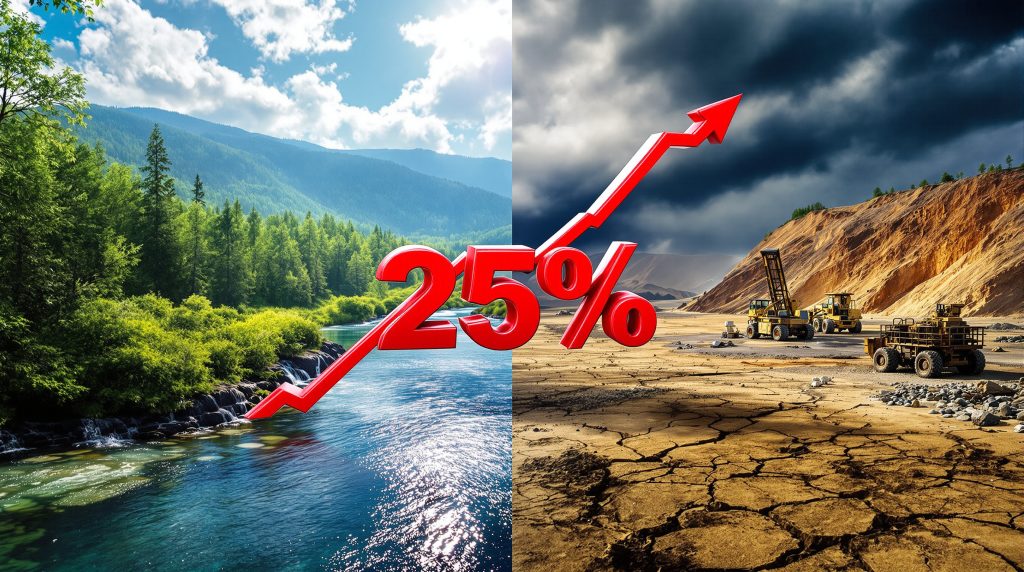## Understanding the Financial Risks of Environmental Degradation to Mining Operations
Nature loss mining earnings is a stark reality for many companies. Environmental degradation threatens mining profits and can sharply affect financial performance. Recent research indicates that this issue may lead to a decline in earnings by up to 25% over five years. Furthermore, the interplay of factors such as water scarcity and regulatory pressure deepens this challenge.
Environmental degradation affects mining profitability in multiple ways. Rising water costs, unpredictable operational disruptions, and evolving environmental regulations all add to the financial strain. In addition, the risk of nature loss mining earnings compounds as companies face unforeseen costs and operational delays.
A detailed analysis by Barclays Bank has highlighted these risks with robust data. For instance, the report examined 250 operational mines and 9,000 power facilities connected with 40 European clients. Moreover, a recent reuters report further corroborates these findings, lending significant weight to these conclusions.
## What is the Relationship Between Nature Loss and Mining Profitability?
The connection between environmental degradation and mining profitability is increasingly evident. As ecosystems deteriorate, mining companies face mounting pressures on their bottom lines. Consequently, the risk of nature loss mining earnings becomes more apparent through various operational challenges.
Mining companies experience these impacts via:
- Increased water acquisition and treatment costs
- Production interruptions due to extreme weather
- Greater compliance costs from stringent regulations
- Limited access to prospective mining sites
- Higher expenses related to remediation and restoration
In addition, recent analysis points to issues such as mining permitting insights that help clarify these regulatory challenges. This evolving framework demonstrates the interconnected nature of environmental and financial risks.
## How Severe Are the Financial Impacts of Biodiversity Loss on Mining?
### The Quantifiable Financial Risk
Recent stress tests conducted by Barclays Bank shed light on quantifiable risks. The studies have shown that mining operations could face a reduction in earnings of nearly 25% over five years, whereas power generation facilities might experience a decline of around 10%. These findings highlight a significant disparity between sectors.
The quantitative data underpinning these projections is compelling. The analysis incorporated hundreds of operational sites and thousands of data points, making it a robust study. Additionally, empirical evidence reveals that nature loss mining earnings is not merely an abstract concern, but a tangible threat to financial stability.
## What Specific Transition Risks Threaten Mining Earnings?
### Regulatory and Policy Pressures
Governmental bodies worldwide are intensifying environmental regulations in response to biodiversity loss. These adjustments not only disrupt operations but also directly contribute to operational costs. For instance, as water scarcity intensifies, water pricing reforms have emerged as a formidable financial pressure on mining operations.
Moreover, stricter pollution controls compel companies to allocate more funds to compliance. Furthermore, the expansion of protected areas limits access to prospective mining sites, while biodiversity offset requirements significantly raise project costs. In addition, discussions on mine reclamation importance often highlight the need to restore ecosystems after extraction.
As a result, transition risks are now the largest component of the projected 25% earnings decline, demonstrating the critical need for companies to adapt to rapidly changing regulations.
## How Do Physical Risks from Nature Loss Affect Mining Operations?
### Operational Vulnerabilities
Direct physical risks, coupled with environmental degradation, lead to various operational challenges. Extreme weather events trigger production delays and often cause forced shutdowns in water-intensive mining processes. For example, drought conditions can lead to interruptions in processing, while flooding may damage critical infrastructure.
Additionally, degraded ecosystems fail to provide natural buffers against extreme weather. Consequently, supply chains also suffer, as transportation networks are disrupted during environmental crises. Given these realities, mining companies must focus on bolstering operational resilience to counter these risks.
In parallel, innovative approaches such as industry innovation trends are emerging to address these very challenges. By adapting and investing in more resilient technologies, companies can mitigate the severe impacts of physical risks.
## The Economic Value of Biodiversity to Mining Operations
### Why Does Nature Loss Matter to Mining Economics?
The dependence of mining operations on intact ecosystems cannot be overstated. Natural systems not only supply a reliable water source but also regulate floods, control erosion, and support climate stability. In essence, maintaining biodiversity is crucial for operational continuity and financial stability.
Mining companies rely on the following ecosystem services:
- A consistent water supply and natural water filtration
- Natural flood regulation and erosion control
- Climate stability ensuring predictable weather patterns
- A social licence to operate within local communities
In addition, as investors score companies based on sustainability, the notion of nature loss mining earnings remains central to financial evaluations.
### How Are Mining Companies Responding to Biodiversity Risks?
#### Strategic Adaptations
Forward-thinking mining companies are beginning to implement comprehensive measures to cope with these evolving risks. They are developing robust biodiversity management plans that exceed basic compliance requirements. In addition, investments in advanced water efficiency technologies and closed-loop systems are on the rise.
Moreover, companies are conducting thorough assessments of their dependencies on nature. Some organisations are even adopting restoration initiatives to foster nature-positive outcomes. In parallel, firms are increasingly discussing green iron production as part of their strategy to address environmental and financial challenges concurrently.
Furthermore, there has been a notable shift toward investment strategies. These measures help secure better access to capital, especially as investors focus on ecological sustainability.
## Measuring and Managing Nature-Related Financial Risks
### What Methodologies Assess Nature-Related Financial Risks?
Financial institutions have started developing sophisticated methodologies to gauge nature-related risks. Emerging frameworks play a crucial role in quantifying these risks across investment portfolios, hence supporting more informed decision-making.
Common methodologies include:
- LEAP framework: a structured approach for evaluating nature dependencies
- Portfolio stress testing: used to quantify risks across client portfolios
- Geospatial analysis: maps operational sites against biodiversity hotspots
- Scenario planning: models environmental policy changes and physical risks
These approaches have proven essential in redefining how nature loss mining earnings is measured, especially when assessing the long-term viability of mining investments. Moreover, a biodiversity frameworks perspective further supports quantifiable risk assessments.
### What Opportunities Exist Alongside These Risks?
#### The Biodiversity Financing Gap
The financial sector recognises that nature-based approaches also offer distinct opportunities. While nature loss mining earnings presents a significant risk, it simultaneously highlights a global biodiversity financing gap estimated at $700 billion annually. This gap represents an untapped opportunity for cost-effective, nature-positive solutions.
Key opportunities include:
- Nature-based solutions that lower operational costs
- Restoration projects that enhance operational resilience
- Innovative financial instruments dedicated to conservation
- Better access to capital as investors focus on sustainability
Proactive mining companies can capitalise on these opportunities, turning challenges into competitive advantages in a rapidly evolving industry.
## Future Outlook: Nature Risk and Mining Profitability
### How Will Nature-Related Financial Risks Evolve?
Emerging trends suggest that environmental pressures on mining operations will only grow. Accelerating biodiversity loss, more stringent environmental regulations, and heightened investor scrutiny are expected to intensify over the coming years.
Furthermore, the combination of water scarcity and altered consumer preferences for responsibly sourced materials contributes to a shifting landscape. Consequently, companies that neglect to mitigate nature loss mining earnings may face even steeper financial declines. Thus, adopting resilient strategies is now more critical than ever.
### What Actions Can Mining Companies Take to Mitigate Earnings Impacts?
#### Strategic Recommendations
To protect their earnings, companies must adapt by implementing comprehensive risk management strategies. Recommended actions include:
- Conducting detailed nature dependency assessments at all operational sites.
- Implementing advanced water efficiency and recycling technologies.
- Developing robust biodiversity management systems that surpass regulatory requirements.
- Actively engaging with evolving policy and community concerns.
- Investing in nature-based solutions that enhance operational resilience.
- Integrating environmental risks into financial planning and capital allocation.
These recommendations should help secure earnings and strengthen the competitive edge in an industry where responsible practices are increasingly demanded. Notably, addressing nature loss mining earnings effectively can pave the way for a more sustainable future.
## The Business Case for Biodiversity in Mining
The financial implications of nature loss mining earnings underscore the urgency for action. As projected impacts reach 25% over five years, companies must recognise that proactive biodiversity management is not merely ethical—it is a sound business strategy.
In addition, improved methodologies and data quality now allow for more accurate integration of environmental risks into financial decision-making. As companies take bold steps to address these challenges, they stand to gain both in terms of operational efficiency and investor confidence.
In conclusion, the interplay between biodiversity and mining economics is undeniable. With well-informed adaptations and strategic investments, mining companies can address the risks and opportunities linked to environmental degradation. The path ahead requires a balanced approach that enhances resilience and secures long-term profitability.
Want to Stay Ahead of ASX Mining Discoveries?
Discover potential high-growth mining stocks before the market reacts with Discovery Alert's real-time notifications on significant ASX mineral discoveries, powered by our proprietary Discovery IQ model. Explore why major mineral discoveries can lead to substantial market returns by visiting our dedicated discoveries page.




